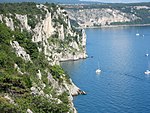United World College of the Adriatic

The United World College of the Adriatic (also known as UWC Adriatic, UWCAd, or in Italian, Collegio del Mondo Unito dell'Adriatico) is an international school in Italy, and a member of the United World Colleges, a global educational movement that brings together students from all over the world with the aim to foster peace and international understanding. The college is attended by around 180 students aged between 16 and 19, from around 80 countries, who live at the college for two years and study for the International Baccalaureate Diploma Programme. The college is located in the village of Duino, near the city of Trieste, in Italy's north-eastern region of Friuli Venezia Giulia, and is located less than 5 km from the Slovenian border. It was founded in 1982, with the support of the Italian government and regional authorities, who are still major financial supporters of the college.
Excerpt from the Wikipedia article United World College of the Adriatic (License: CC BY-SA 3.0, Authors, Images).United World College of the Adriatic
SP2, Duino Aurisina / Devin - Nabrežina
Geographical coordinates (GPS) Address Nearby Places Show on map
Geographical coordinates (GPS)
| Latitude | Longitude |
|---|---|
| N 45.7733 ° | E 13.6053 ° |
Address
SP2
34011 Duino Aurisina / Devin - Nabrežina
Friuli-Venezia Giulia, Italy
Open on Google Maps






